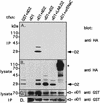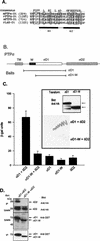The second catalytic domain of protein tyrosine phosphatase delta (PTP delta) binds to and inhibits the first catalytic domain of PTP sigma
- PMID: 9566880
- PMCID: PMC110640
- DOI: 10.1128/MCB.18.5.2608
The second catalytic domain of protein tyrosine phosphatase delta (PTP delta) binds to and inhibits the first catalytic domain of PTP sigma
Abstract
The LAR family protein tyrosine phosphatases (PTPs), including LAR, PTP delta, and PTP sigma, are transmembrane proteins composed of a cell adhesion molecule-like ectodomain and two cytoplasmic catalytic domains: active D1 and inactive D2. We performed a yeast two-hybrid screen with the first catalytic domain of PTP sigma (PTP sigma-D1) as bait to identify interacting regulatory proteins. Using this screen, we identified the second catalytic domain of PTP delta (PTP delta-D2) as an interactor of PTP sigma-D1. Both yeast two-hybrid binding assays and coprecipitation from mammalian cells revealed strong binding between PTP sigma-D1 and PTP delta-D2, an association which required the presence of the wedge sequence in PTP sigma-D1, a sequence recently shown to mediate D1-D1 homodimerization in the phosphatase RPTP alpha. This interaction was not reciprocal, as PTP delta-D1 did not bind PTP sigma-D2. Addition of a glutathione S-transferase (GST)-PTP delta-D2 fusion protein (but not GST alone) to GST-PTP sigma-D1 led to approximately 50% inhibition of the catalytic activity of PTP sigma-D1, as determined by an in vitro phosphatase assay against p-nitrophenylphosphate. A similar inhibition of PTP sigma-D1 activity was obtained with coimmunoprecipitated PTP delta-D2. Interestingly, the second catalytic domains of LAR (LAR-D2) and PTP sigma (PTP sigma-D2), very similar in sequence to PTP delta-D2, bound poorly to PTP sigma-D1. PTP delta-D1 and LAR-D1 were also able to bind PTP delta-D2, but more weakly than PTP sigma-D1, with a binding hierarchy of PTP sigma-D1 >> PTP delta-D1 > LAR-D1. These results suggest that association between PTP sigma-D1 and PTP delta-D2, possibly via receptor heterodimerization, provides a negative regulatory function and that the second catalytic domains of this and likely other receptor PTPs, which are often inactive, may function instead to regulate the activity of the first catalytic domains.
Figures








Similar articles
-
The LAR/PTP delta/PTP sigma subfamily of transmembrane protein-tyrosine-phosphatases: multiple human LAR, PTP delta, and PTP sigma isoforms are expressed in a tissue-specific manner and associate with the LAR-interacting protein LIP.1.Proc Natl Acad Sci U S A. 1995 Dec 5;92(25):11686-90. doi: 10.1073/pnas.92.25.11686. Proc Natl Acad Sci U S A. 1995. PMID: 8524829 Free PMC article.
-
Multiple interactions between receptor protein-tyrosine phosphatase (RPTP) alpha and membrane-distal protein-tyrosine phosphatase domains of various RPTPs.J Biol Chem. 2000 Apr 28;275(17):12446-52. doi: 10.1074/jbc.275.17.12446. J Biol Chem. 2000. PMID: 10777529
-
Intra- and intermolecular interactions between intracellular domains of receptor protein-tyrosine phosphatases.J Biol Chem. 2002 Dec 6;277(49):47263-9. doi: 10.1074/jbc.M205810200. Epub 2002 Oct 9. J Biol Chem. 2002. PMID: 12376545
-
Functional significance of the LAR receptor protein tyrosine phosphatase family in development and diseases.Biochem Cell Biol. 2004 Dec;82(6):664-75. doi: 10.1139/o04-120. Biochem Cell Biol. 2004. PMID: 15674434 Review.
-
The leukocyte common antigen-related protein LAR: candidate PTP for inhibitory targeting.Curr Top Med Chem. 2003;3(7):809-19. doi: 10.2174/1568026033452294. Curr Top Med Chem. 2003. PMID: 12678846 Review.
Cited by
-
High-resolution crystal structures of the D1 and D2 domains of protein tyrosine phosphatase epsilon for structure-based drug design.Acta Crystallogr D Struct Biol. 2018 Oct 1;74(Pt 10):1015-1026. doi: 10.1107/S2059798318011919. Epub 2018 Oct 2. Acta Crystallogr D Struct Biol. 2018. PMID: 30289412 Free PMC article.
-
A novel binding pocket in the D2 domain of protein tyrosine phosphatase mu (PTPmu) guides AI screen to identify small molecules that modulate tumour cell adhesion, growth and migration.J Cell Mol Med. 2023 Nov;27(22):3553-3564. doi: 10.1111/jcmm.17973. Epub 2023 Oct 20. J Cell Mol Med. 2023. PMID: 37860940 Free PMC article.
-
Large-scale structural analysis of the classical human protein tyrosine phosphatome.Cell. 2009 Jan 23;136(2):352-63. doi: 10.1016/j.cell.2008.11.038. Cell. 2009. PMID: 19167335 Free PMC article.
-
Structural Basis for LAR-RPTP-Mediated Synaptogenesis.Mol Cells. 2018 Jul 31;41(7):622-630. doi: 10.14348/molcells.2018.0202. Epub 2018 Jul 11. Mol Cells. 2018. PMID: 30008201 Free PMC article. Review.
-
Identification of STAT3 as a substrate of receptor protein tyrosine phosphatase T.Proc Natl Acad Sci U S A. 2007 Mar 6;104(10):4060-4. doi: 10.1073/pnas.0611665104. Epub 2007 Feb 21. Proc Natl Acad Sci U S A. 2007. PMID: 17360477 Free PMC article.
References
-
- Barnea G, Silvennoinen O, Shaanan B, Honegger A M, Canoll P D, D’Eustachio P, Morse B, Levy J B, LaForgia S, Huebner K, Musacchio J M, Sap J, Schlessinger J. Identification of a carbonic anhydrase-like domain in the extracellular region of RPTPγ defines a new subfamily of receptor tyrosine phosphatases. Mol Cell Biol. 1993;13:1497–1506. - PMC - PubMed
-
- Bilwes A M, den Hertog J, Hunter T, Noel J P. Structural basis for inhibition of receptor protein-tyrosine-α phosphatase by dimerization. Nature. 1996;382:555–559. - PubMed
-
- Brady-Kalnay S M, Tonks N K. Identification of the homophilic binding site of the receptor protein tyrosine phosphatase PTPμ. J Biol Chem. 1994;269:28472–28477. - PubMed
Publication types
MeSH terms
Substances
LinkOut - more resources
Full Text Sources
Molecular Biology Databases
Research Materials
Miscellaneous
